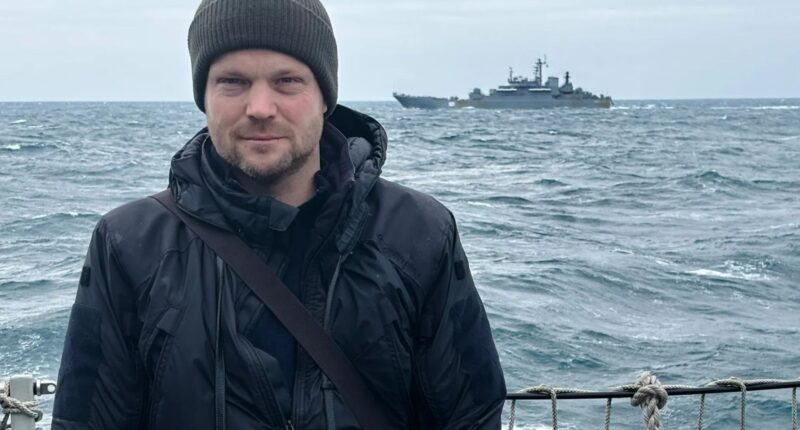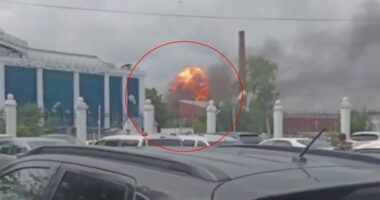THIS is the moment Sun Man Jerome Starkey joined Royal Navy gunboats as they intercepted a Russian convoy in a dramatic Channel showdown.
HMS Iron Duke charged at full speed up to a Russian warship as a naval Wildcat helicopter swooped and circled as low as 80ft above the waves.




Armed Russian sentries scrambled to man machine guns on the decks of landing ship Aleksandkr Otrakovskiy, which led the six-vessel convoy.
Waves crashed over the Royal Navy frigate as it closed to within 1,000 yards of the rusting Russian warship.
The Wildcat chopper – with The Sun proudly onboard – was half that distance away as it scanned the Russian tank transporter with high-tech sensors and thermal optics.
It was the first time journalists have joined a Royal Navy intercept mission in living memory.
Cockpit displays in the Wildcat showed Russian sailors with Kalashnikov rifles slung across their chests as comrades manned heavy machine guns mounted on the warship’s bows.
It is the closest Britain’s armed forces have come to Russia’s military since tyrant Vladimir Putin illegally invaded Ukraine three years ago.
HMS Iron Duke, a Type 23 frigate, was one of four Royal Navy vessels that stalked the Russian ships towards a home base in the Baltics.
Plucky HMS Cutlass, one of the smallest warships in the impressive fleet, shadowed the convoy through the Strait of Gibraltar.
The Spanish and French navies watched them up to Brittany where Britain’s RFA Tideforce and the offshore patrol ship HMS Tyne joined the French ship Rhone.
They were backed overhead by two French Rafale fighter jets – which flew multiple passes at 300ft – and an RAF P-8 Poseidon spy plane.
HMS Iron Duke’s captain Commander David Armstrong insisted the mission was vital to Britain’s security.
He told The Sun: “It is not enough to hope the Russians won’t do anything detrimental to our security.
“We need to be here to make sure they can’t.”
It was the 13th time his frigate, known as the Fleet Ready Escort, has bravely scrambled to meet Russian ships in the last six months.
The increased patrols come amid claims that Russia is attacking vital subsea cables in the Baltic Sea.
Cdr Armstrong added: “Part of Russia’s doctrine is quick wins, deescalate and deny – and that is what we are trying to guard against.
“They could cut subsea cables, say it’s nothing to do with us, and then ask the West ‘what are you going to do about it?’.
“The mission of the Fleet Ready Escort is to make sure the Russians – or any non-allied nation – don’t have that opportunity, because we are watching.



He added: “As a maritime nation we rely on trade by sea. So much of our food, our energy and data travels on or under the sea.
“Sea lines of communication are of critical importance.
“The protection of our critical national infrastructure relies on control of our territorial seas.”
HMS Iron Duke steamed out of Portsmouth at dusk on Wednesday as the Russian convoy approached Lands End.
The 436ft long frigate was armed Sting Ray torpedoes, devastating Sea Ceptor missiles, a 4.5inch main gun and crucially a well drilled crew of 180, ranging from 18 to 55 years old.
They were joined under the cover of darkness by a Wildcat naval helicopter from 815 Naval Air Squadron based at Yeovilton, Somerset.
Cdr Armstrong insisted he is never trying to give Putin or Russia a message but just doing his job.
He added: “What I can say, as the captain of a warship, is that if you are a non-allied vessel and you pose a potential threat to UK interests you should expect the Royal Navy to monitor you because that has been our job for hundreds of years.
“It is what the Navy does.”
As dawn broke on Thursday HMS Iron Duke was lurking beyond the horizon, out of sight of the Russian convoy.
On the captain’s orders, the engineers below deck spun up the ship’s two gas turbine engines which provided a power boost as they hit a top speed of 28 knots.
At the same time Wildcat launched from the flight deck and roared into view of the Russians.



At one point, commercial shipping forced HMS Iron Duke to close in to 1,000 yards of the Aleksandr Otrakovskiy before later opening up to two miles.
Cdr Armstrong said a sentry appeared on the top deck and sailors in body armour manned their ship’s machine guns.
But he insisted it was “nothing overly aggressive”.
The Russian flotilla included two warships, two container ships and two oil tankers for refuelling en route.
The pair of warships – the Aleksandr Otrakovskiy and Ivan Gren – were escorting container ships merchant vessels Sparta I and Sparta II, and the oil tankers General Skobolev and Yelnya.
Experts suspect they were laden with thousands of tons of arms and munitions after Moscow was forced to evacuate its Tartus naval base in Syria when former President Bashar al Assad was toppled by rebels last year.
At no point did the vessels pose a specific threat to Britain and the crews were “safe and professional,” the Navy said.
But there are fears the weapons on board will be used against Ukraine.
SEA SABOTAGE
Their passage through the Channel came days after Defence Secretary John Healey vowed to take “robust action” against suspected Russian subsea sabotage.
He ordered an Astute class nuclear submarine to surface yards away from the Russian spy ship Yantar last year after it was suspected of interfering with subsea cables in the Irish Sea.
In a stark message to President Putin, Healey said: “We see you.
“We know what you are doing and we will not shy away from robust action to protect this country.”
Finland also boarded a Russian vessel suspected of dragging its anchor to deliberately sever an internet cable.
And Baltic states are considering using anti-piracy laws to seize Russian “ghost ships” which are smuggling oil to evade global sanctions.
Why are there fears over subsea sabotage?

SUSPICIONS have been raised over potential deep sea disruption from Putin’s Russia after a string of key underwater cables have been sliced in recent months.
In January, Russia was accused of sabotage in the Baltic Sea after a Kremlin ship allegedly cut a key Finish power cable with its anchor after dragging it on the seabed for dozens of miles.
The Estlink 2 power cable in the Gulf of Finland was ruptured along with four other communication lines in the suspected deliberate act of vandalism.
Officials believe the ship was a 751ft Eagle S part of Russia’s “shadow” or “dark” fleet operated by Putin to evade sanctions.
A Chinese vessel was also seen in the area at the time of the incident.
Since Vlad’s invasion of Ukraine almost three years ago, Russia have been using hybrid warfare tactics to get to their enemies.
This has typically targeted nations who have strongly backed Ukraine such as Germany by targeting critical infrastructure, such as undersea cables.
The recent issues have prompted Nato to bolster up their surveillance systems across Europe.
A giant 36ft stealth submarine drone dubbed the “Blue Whale” has been deployed in the Baltic Sea by Germany.
The huge drone is set to patrol across European waters on behalf of Nato after being released by the Germany navy.
The autonomous Blue Whale’s goal is to carry out deep sea surveillance in the Baltic Sea.
Its capabilities also include the ability to detect and pursue suspicious vessels as well as mines linked to foreign interference.
German navy commander Jan Christian Kaack says it will confront “high-performance weapons from potential foes, including some which are extremely difficult to defend against”.
But for many of the crew it was just another day at work.
Leading Seaman James Chadwick, 24, from Manchester said: “To us it is just a standard day.
“We have been trained to do it, we know exactly what to do and how to react in any situation.”
He said team work was key to the vessel’s success.
He added: “You always have to rely on teamwork. If you don’t have the engineers or the medics or the chefs it wouldn’t run.”
Sailors like James spent a staggering 215 days away from home last year.
His shipmate Louis Barker, 21, from Skipton, said the sense camaraderie was key.
He said: “People always have so much going on at home it can be very very difficult.
“When you talk about teamwork you have got to make sure your oppos and the people around you are doing alright.”
Commander Armstrong agreed as he said: “The British people are very lucky that we have young sailors who are so dedicated to king and country that they are prepared to do this.
“This is service, and we all signed up, but sometimes the public forgets.”



















